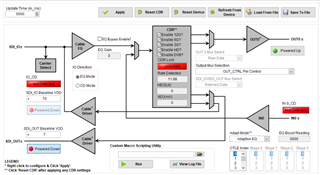Tool/software:
Hi there,
This application note (https://www.ti.com/lit/an/snla299/snla299.pdf) details a use case where the LMH1297 can be used as an SDI bidirectional IO as well as a MADI cable driver simultaneously.
The application note provides no details on how this configuration is supported, and which register bits need to be set to support this. It is my understanding that the SDI_OUT cable driver cannot be used as a standalone cable driver when SDI_IO is used in EQ mode, however this is contradicted by two of the four modes detailed in that application note.
Can anyone elaborate further on how this shared SDI/MADI mode works?
Thanks


